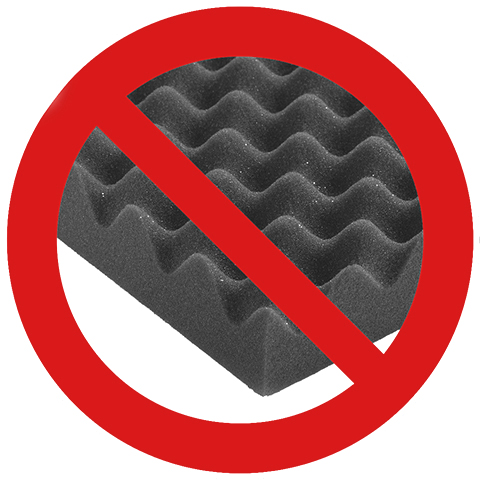A quiet boating season
It's high time to inspect your boat for the upcoming boating season! The weather is getting better and people are looking forward to getting on the water. But boat maintenance is a never ending project. A lot of our customers tell us that they want to improve or renew their boat's insulation this year in order to obtain more cruising comfort. We would love to advise you concerning this topic!
Replacing old absorption material with new and better products
This spring, many of our customers equip their machine room or engine housing with new insulation or absorption material. Often they are motivated by the fact that the old material had it's time. In the past, convoluted foam was often used in the engine room, because people thought this was the best solution. However, the opposite is true: never use convoluted foam in a boat, yacht, or sloop! The reason for this is that the material doesn't contain a protective top layer, allowing oil, moisture and dirt to penetrate the foam. This decreases the lifespan of the material, plus it makes the material look dirty (in a dry and clean environment the product functions well).
In yacht- and shipbuilding, we recommend using flat foam with a protective top layer that suits your situation. The most common top layers are the PU and FC top layer. The PU top layer can be applied at temperatures up to 80, maximum 90°C, absorption material with a FC top layer at temperatures up to max. 150°C (this may vary per product).
Absorbing engine noise
Noise produced by the engine should not only be insulated, but also be absorbed. In this way, the chance that noise will leak from the machine room or housing through seams and crevices becomes smaller. Wrap the engine as much as possible with an absorption material that has the right heat resistance and is as thick as possible. The thicker the applied absorption material, the better the end result will be. Which absorption material you should use depends on situation. You should choose a product with the right properties for the space or room in question, such as heat-resistance, type of top layer, and colour.
Absorption materials
- Merfocell PU: Absorption foam provided with an oil-, dirt-, and moisture-proof top layer. Resistant against temperatures up to +80 °C.
- Acusticab: Absorption foam provided with an oil-, dirt-, and moisture-proof top layer. Resistant against temperatures up to +80 °C.
- Merfocell FC: Absorption foam provided with a glass cloth fiber top layer. Resistant against temperatures up to +110 °C.
- Flamex FC: Absorption foam provided with a glass cloth fiber top layer. Resistant against temperatures up to +150 °C. Only applicable on flat substrates.
- Merfocom: Luxurous combined plate with an Isomat sound absorbtion core. Glass cloth fiber top layer resistant against temperatures up to +110 °C.
Finishing for absorption materials
- PU Finishing Tape: Masking tape, made from a self-adhesive PU-film. Suitable for masking Acusticab, Flamex PU en Merfocell PU. Resistant up to 80 °C.
- Merfotape GW: Masking tape with a glass cloth fiber top layer. Suitable for seams between Flamex GW, Merfocom en Merfocell GW plates. Resistant up to 60 °C.
Insulating engine noise
Insulating engine noise should be done by applying a combination of insulation and absorption materials. But your starting point are heavy insulation plates. Low frequency engine noise is optimally blocked when you make the shutter, wall, housing or cover as heavy as possible. Mass = insulation. As for the insulation of such surfaces, you should make use of Isomat. There are two variants of Isomat, for small jobs you should use Isomat TS and for bigger ones Isomat KM. You glue Isomat to the substrate by means of contact adhesive. This substrate is often made from wood or a synthetic material. The heavier you make the thing that divides the engine from your ears, the higher the insulation value will be. The same applies to the floor of the deck. If you don't have a housing around your engine yet, but you do have space for it, we recommend getting or making one. To this end, we recommend using Merfoplex.
Insulation materials
- Isomat TS : Heavy synthetic insulation plate.
- Isomat KE : Heavy rubber/bitumen insulation plate (minimal order quantity 5 m²).
- Merfocom : Luxurous combination plate for insulation and absorption.
- Merfoplex : Heavy acoustic construction plate.
Insulating the propeller, bow thruster, or propulsion this year?
The propeller, and especially the bow thruster, can cause more noise nuisance throughout the whole vessel than you might think. Vibration from the engine and the propellers easily travel through the ship hull. By applying the sandwich anti-drumming method this problem can be strongly reduced. This method of insulation (anti-drumming) is applied in order to reduce, amongst others, cavitation and noise from the bow thruster. By applying at least one squared metre around the propeller (shaft), bow thruster, or the engine(s) with sandwich anti-drumming material, you can diminish the sound problem enormously.
Insulation and anti-drumming products
- Vibradamp A90P: Two component paste for the anti-drumming of steel or synthetics. Used in combination with Zincor steel plates.
- Isomat TS: Synthetic insulation plate with a high density for insulating light polyester walls, shutters, and ship hulls.
Outboard engine insulation
As for the insulation of the outboard engine and the well, we have a seperate advice article, in which you can read how to insulate the outboard engine and which materials to use.
Questions? 
Do you have any questions concerning this topic? Make sure to have a look at our page dedicated to boats and yachts for more solutions with regards to sound insulation on board. Do you still want more information? Please feel free to contact us, we would like to help you.

 Sound Absorption
Sound Absorption  Sound Insulation
Sound Insulation  Vibration Isolation
Vibration Isolation  Silent Ventilation
Silent Ventilation  Accessories
Accessories  Thermal & Acoustic Insulation
Thermal & Acoustic Insulation